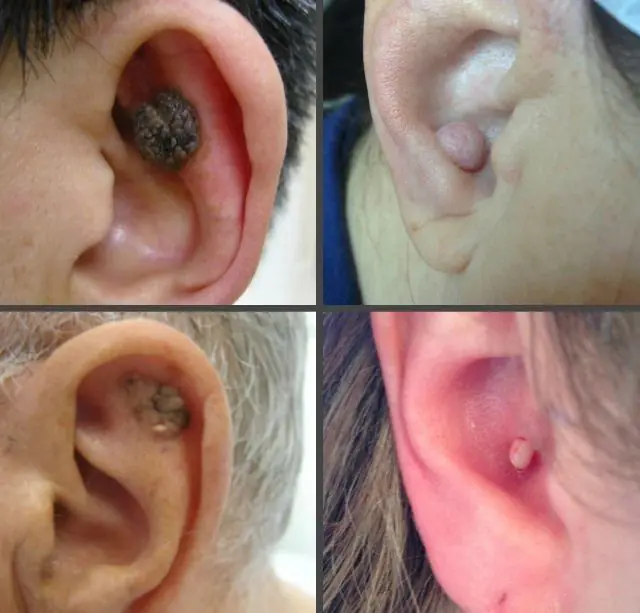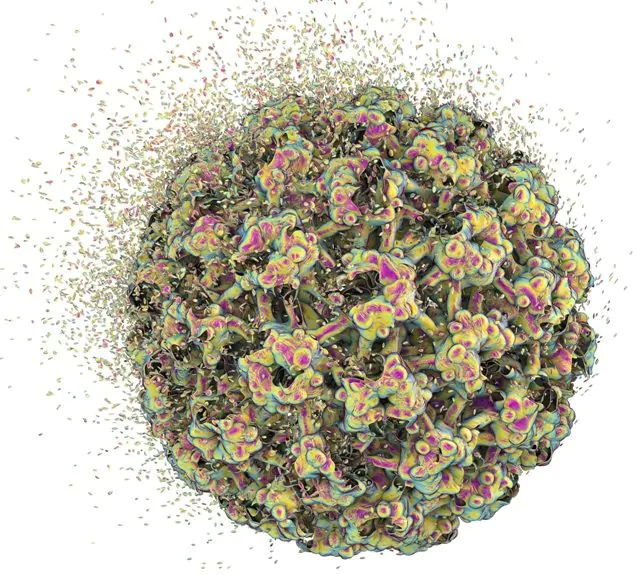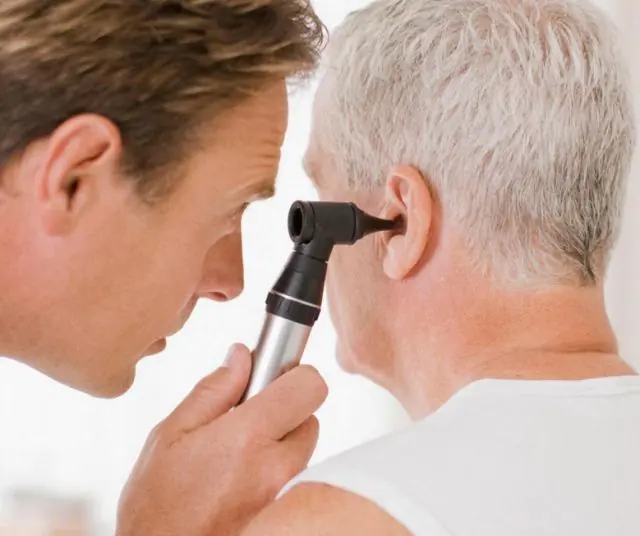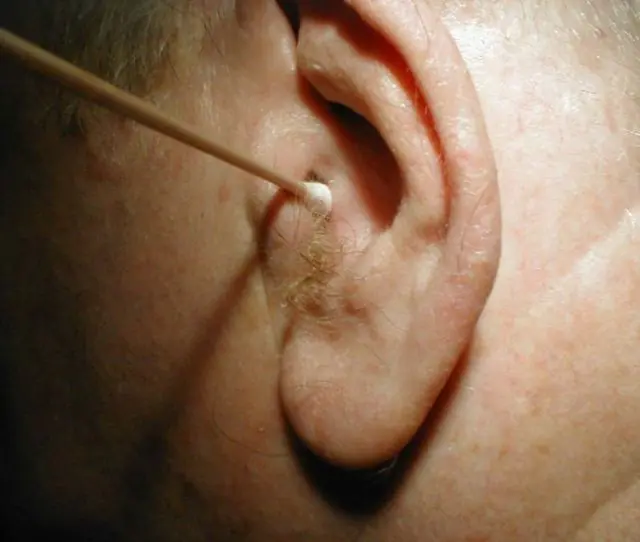
- What do papillomas look like in human ears?
- Reasons for appearance
- Diagnostic methods
- Treatment options
- Removal of papillomas in the ears
- Medicines
- Folk remedies
Papillomas in the human ears are benign growths on the skin that can be localized in different parts of the organ - from the lobe and concha to the internal passages. Such neoplasms require treatment, as they can sometimes degenerate and become malignant tumors.
What do papillomas look like in human ears?

In the photo there are papillomas in the ears
Papillomas can appear on any human organ, both externally (on the skin) and inside the body (on the mucous membrane). The ears are one of the “favorite” places for these tumors to occur. They are benign, painless and, as a rule, do not cause discomfort to a person. However, the appearance of growths on visible parts of the body, for example, on the earlobes, can cause aesthetic inconvenience and cause psychological discomfort.
The forms of papillomas on the ear can be different. Let's look at the most common ones:
- Filiform. Most often it affects the area near the ear canal or concha. Initially they look like plaques with a slightly yellow tint. Gradually they grow in size and become denser. They are attached by a thin stalk to the epithelium.
- Ordinary or vulgar. Usually located in the auricle or ear canal. At first they have a smooth surface. Over time, they become rough and have uneven edges.
- Flat. They are considered “juvenile” because in most cases they affect young people during puberty. They are located on the earlobes or in the shells. They have a smooth surface and protrude slightly above the surface of the skin.
The shade of ordinary papillomas in the ear can range from flesh-colored to dark brown. The neoplasm acquires a dark color over the years.
As a rule, these growths do not grow to large sizes, but sometimes they can block the ear canal and significantly affect hearing acuity.Symptoms of the formation of papillomas in the human ears are:
- A burning sensation, itching in the area where the tumor forms.
- If the growth is localized near the middle ear, then nausea and problems with orientation in space may occur. This is due to the effect of the tumor on the human vestibular apparatus.
- If the papilloma grows into the eardrum, then bleeding, inflammation and suppuration may appear in this ear area.
Thus, in order to avoid serious complications caused by the growth of papillomas in the ear, it is necessary to undergo a consultation with a specialist and subsequent treatment.
Causes of papillomas in human ears

The only reason that can cause papillomas to appear in a person’s ears is HPV infection. This is a virus that has many strains and is highly contagious. On the planet, according to various estimates, from 60 to 90% of people are infected with one or another type of papillomavirus.
Some strains have a high level of oncogenicity, others have a low level. As a rule, papillomas in the ear occur due to infection with viruses with low oncogenicity. However, cancerous degeneration of tumors can also occur as a result of trauma to the papilloma.
HPV is transmitted from a sick carrier to a healthy one through household contacts and sexual relations. In rare cases, transmission of the pathogen from mother to child occurs during pregnancy and childbirth. The virus can be transmitted especially quickly in conditions of high humidity, for example, in public swimming pools, baths, saunas, and gyms.
This pathogen is capable of maintaining viability in the human body for a long time without manifesting itself. When “favorable” circumstances occur, HPV begins active activity, which is expressed in the formation of benign neoplasms on the skin, including on the ears.
The main factors contributing to the appearance of papillomas on the ear:
- A history of chronic illnesses;
- Frequent overwork, nervous stress;
- Increased physical activity;
- Prolonged or uncontrolled use of antibiotics;
- Problems in the functioning of the human immune system;
- Unfavorable environmental situation;
- Physical inactivity, poor nutrition, bad habits;
- Hypothermia, infectious respiratory diseases.
Also, the appearance of papillomas on the ear is often provoked by a disruption in a person’s hormonal levels, which can occur for a number of reasons - from age-related changes to special physiological conditions, such as pregnancy.
- Read also: what causes papillomas: the main reasons
Methods for diagnosing papillomas in human ears

Diagnostic measures should begin with a visit to the therapist’s office. This doctor will then refer the patient to a specialized specialist - an otolaryngologist, dermatologist or oncologist.
In most cases, a visual examination is sufficient to determine the nature of the papilloma on the ear. However, sometimes special studies are required to clarify the diagnosis. In such cases, a specialist may recommend undergoing the following examinations:
- Otoscopy. A special device with a mirror and a funnel is used. An otolaryngologist performs the examination.
- Computed tomography or magnetic resonance imaging. Required when small papilloma is localized on the ear outside or on the surface of the eardrum.
- Microscopy. The growth is studied using a special magnifying microscope.
- Probing. A special probe is used, which is inserted into the ear canal and examines the surface when tumors are localized deep in the ear.
- Biopsy. This is a diagnostic procedure that involves taking biological material for examination to determine the presence of malignant cells. Usually performed on a tumor that has already been removed.
Also, if HPV is suspected, a general and special blood test is required. A blood test will help identify the virus, find out its strain, as well as the viral load on the body. This will allow you to prescribe the correct drug therapy if necessary.
Methods for treating papillomas in the human ears
Today, there are several main areas of treatment for papillomas in the human ears. Maximum effectiveness is achieved with combination therapy. Usually, removal of the tumor is prescribed followed by medication. You can also supplement the main treatment course with traditional medicine recipes.
Removal of papillomas in the ears

Removing growths in the ears is the main way to combat them. It should be remembered that such treatment does not guarantee the absence of relapses in the future. Today, papillomavirus cannot be completely eliminated from the body. Once infected, a person remains a carrier of the virus forever, even if he has no symptoms of the disease.
Removal of papilloma in the ear is carried out in the following ways:
- Electrocoagulation. This procedure uses alternating or direct electric current, which is applied to the growth. Local anesthesia is required, as the procedure is quite painful. After such treatment, scars may remain at the removal sites. It takes about 14-16 days for complete tissue restoration. The price of electrocoagulation for papillomas in the ears is 1200-2400 rubles in Russia and 300-630 hryvnia in Ukraine.
- Cryoremoval. This manipulation involves the use of special chemicals, most often liquid nitrogen. Its applicator is applied pointwise to the neoplasm. During the process of dying, the growth darkens and disappears in 2-3 weeks. The procedure is not very painful, anesthesia may not be used. There is no bleeding. Scars may remain after surgery. The cost of cryoremoval of papilloma on the ear is 650-1550 rubles in Russia and 270-450 hryvnia in Ukraine.
- Cauterization with acids or alkalis. In this procedure, a mixture of organic or inorganic acids, as well as alkaline agents, is applied to the affected area. They cause the death of diseased tissues. A crust forms at the site of exposure, which should fall off on its own within a couple of weeks. Do not tear off the crust until it has completely healed to avoid scarring. The price of chemical cauterization of papilloma is 700-1500 rubles in Russia and 300-470 hryvnia in Ukraine.
- Laser coagulation. One of the most modern and painless methods of removing papillomas in the ear. A laser beam of different powers is used, which allows you to adjust the depth of penetration into the tissue and acts as accurately as possible. The skin at the removal site is completely restored within a month. As a rule, no scars remain after treatment. The cost of laser removal of papilloma is 1100-2300 rubles in Russia and 350-650 hryvnia in Ukraine.
- Radiosurgery. A radio knife or a special loop is used. The tumor is irradiated with a large number of ions. The growth is accurately and painlessly cut off with a radio knife and sent for histological examination. Healing occurs very quickly, and injury to neighboring tissues is excluded in this case. Scars do not form. The price of radiosurgical removal of papilloma in the ear is 2000-3200 rubles in Russia and 650-1250 hryvnia in Ukraine.
After any procedure to remove a tumor from the auricle or canal, certain recommendations should be followed: do not allow water to enter the site of tissue regeneration until complete healing, do not wear hats, limit the time spent in direct sunlight.
Treatment of papillomas in the ears with medications

In the photo there are drugs for papillomas in the ears
Drug treatment for HPV is aimed at developing strong immunity in humans and strengthening the body’s protective functions. It can be quite effective for single papillomas on the ears and allows you to consolidate the results and avoid relapses after removal of multiple tumors.
As a rule, drugs from the group of antiviral drugs, as well as immunomodulators, are prescribed. The latter stimulate the process of interferon formation, strengthen the immune system, and help the body fight the virus more effectively. The following products have proven themselves to be excellent: Amiksin (from 650 rubles) and its analogues Derinat (450 rubles and above) and Lykopid (400-700 rubles).
Among the drugs of the antiviral group, Panavir (from 1,500 rubles) and its analogues Viferon (from 500 rubles) and Cycloferon (300 rubles and above) effectively combat HPV, which causes papillomas on the ears.
Also, to reduce the risk of relapse, the doctor may prescribe the patient to take multivitamins and dietary supplements that will work to strengthen the body’s immune response and fight the pathogen.
Folk remedies against papillomas in the ears

The main rule when using traditional medicine methods is “do no harm.” You can use folk wisdom in the treatment of papillomas in a person’s ears as an addition to the main therapy and only after consulting a doctor.
The following methods have earned trust:
- Lubricate the growth in the ear with a mixture of celandine (100 g), aspirin (3 g), iodine (25 g), boric acid (2 g).
- Squeeze the juice from fresh cabbage leaves and apply it in the form of compresses to the papilloma.
- Make compresses from a 3% solution of hydrogen peroxide for 5-7 days.
- Squeeze the juice from freshly cut celandine and lubricate the papillomas in the ears with it.
- Mix a paste of grated garlic cloves with baby cream and apply the mixture to the new growth for 30 days.
- Lubricate the growth with pure chicken protein several times a day.
It is also useful to take vitamin decoctions and herbal infusions, as well as drinks that stimulate the immune system. St. John's wort, coltsfoot, hawthorn, rose hips, thyme, dandelion root, mint, chamomile, black currant and raspberry leaves help strengthen the body's protective functions.
Photos of papillomas on the ear can be found on the Internet. Many people try to diagnose themselves based on such images. However, this should not be done. Remember that only a specialist can determine the exact cause of the appearance of tumors on the ears and prescribe the correct treatment. This will help avoid relapses and complications.
- Related article: When to contact an ENT specialist for papillomas



